Do you remember that girl in class who prepared her homework to near perfection and had it ready way before it was due? Yup, that was me.

So when I became Head of Product for the first time in 2016, I took it upon myself to create the “perfect” product vision, mission, and strategy. I did my homework — I read the studies, talked to experts and customers, analyzed the competition, and understood the market trends. I was confident that no one knew our product, market, and target customer better than me. Cocky, indeed.
After investigating, drafting, iterating, and prettifying for months, I felt ready to present my work. I organized a six-hour “workshop” for upper management and the product/dev team. I presented my beautiful pitch deck with confidence and explained the “why” behind my decisions. The Q&A section was short, with maybe a handful of questions from the head of sales and marketing. The product and dev teams just nodded.
Operation success, I thought.
However, after only a few short weeks, complaints started piling in from all sides. I heard, “There’s a lack of strategy,” “The product team acts like a headless chicken,” and, “There’s no red thread in the roadmap.”
I didn’t understand! Had we not been over exactly this?
I learned the hard way that my overzealous preparation had led to a detrimental issue: a lack of buy-in. As a product advisor and coach, I see other heads of product making that same mistake over and over.
In this article, we’ll talk about co-creation and how to be a successful collaborator. It’s easy to want to do things yourself, but there is strength in numbers. Co-creating the right way will make a world of difference.
Co-creation is about inviting the right people in at the right time to work on something together in the right format. You do this by providing them with the right level of context to be able to contribute.
I’ll unpack each of these aspects in the FAQs, after diving into the co-creation fundamentals:
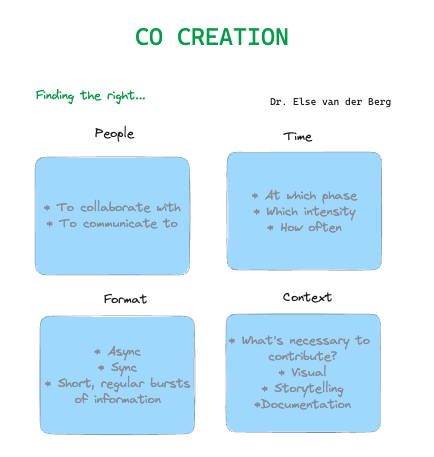
Over-preparing your work is a double-edged disaster:
So why is co-creating the better option?
You’re in the position to act as a lighthouse to your colleagues. By openly showing your imperfect work and inviting the right people in early, you can create a culture of collaboration. Death to information-hogging!
There are two fundamentals to co-creation: understanding your role and building self-confidence.
Firstly, ownership does not mean you’re supposed to execute on your own. Creating the product vision, mission, and strategy is not your homework as the head of product. These are integral to your company’s strategy, and they need to be created in close alignment with the rest of the leadership team.
So, if you’re not supposed to lock yourself in a room and churn out a 20-page document, what should you be doing?
Co-creation means being deeply curious about feedback. This doesn’t mean you need to incorporate everything that you’re told, but it does mean trying to understand your colleagues’ point of view, for example by asking open questions or multiple “why?”s.
Always remember: you aren’t your work or your ideas. Critical feedback to your work is not an attack on you. The more you get comfortable with sharing rough, early work, the less painful it will be to accept feedback:
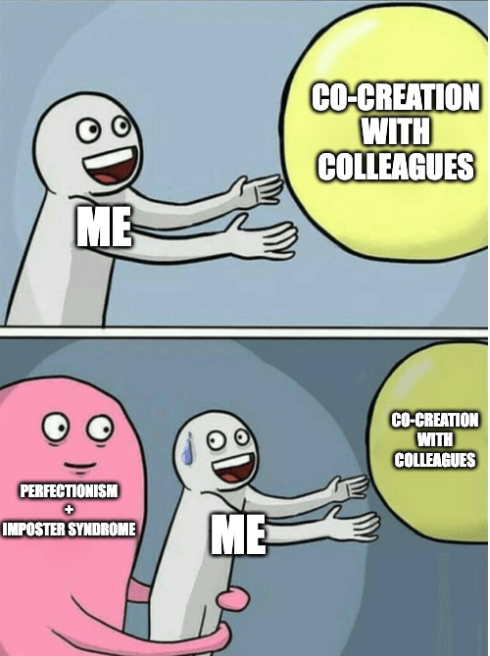
Now, let’s answer a few questions about the co-creation process.
There are three types of stakeholders here that should be informed and participate: directly and indirectly affected stakeholders.
Ask yourself, “What are the success criteria for what I’m working on?” Having a well-formulated product strategy neatly typed up on your company’s internal Wiki page does not equal success.
A product strategy is successful when it “works,” meaning its execution is driving the company’s broader strategy and goals. This requires lots of different stakeholders to play ball:
Involving stakeholders who are likely to be indirectly affected could be key to avoiding nasty surprises. Examples are:
Simple rule of thumb: those who are directly affected and eager to participate will get a collaborative role (potentially at different stages of your project), and everyone else will be informed.
If you’re not sure whether you’ve considered the right people, you can mention the project during an all-hands meeting and invite people to speak to you if they feel they should have been involved.
When selecting your co-creation group, you’ll need to strike the balance between efficiency and making sure all the right people are invited. The bigger your group becomes, the less efficient decision-making will be. It’s up to you, considering your organizational culture, to decide which side you should err on.
It helps to remember and communicate that most decisions are two-way door decisions, meaning they’re reversible. If you failed to include someone important early on, that’s a shame, but not a cardinal sin:
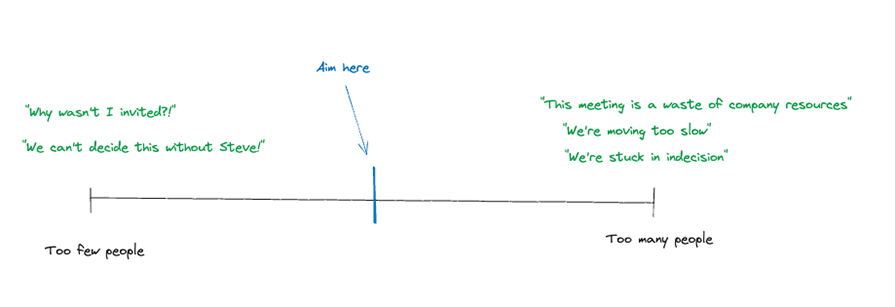
There’s no silver bullet to co-creation, but there are a few things that worked well for me in the past:
How can I provide the right level of context (without overloading my colleagues?)
As the owner of a topic, you’ll likely have a lot more knowledge or context than anyone else, which makes it much harder to accept anyone’s feedback. Jumping back to my first Head of Product role in 2016, I was confident that I knew most about our competitive landscape and customers. So why listen to the feedback of anyone else?
People usually do one of two things:
Don’t be either of those people. It’s your job to:
This might feel like extra work on your plate. One of the most important skills to learn is to trim the fat, to be able to distinguish what’s important from what’s not. You can easily tell the difference between a junior person from a senior by how well they can focus on what matters and communicate clearly. So consider this an exercise:
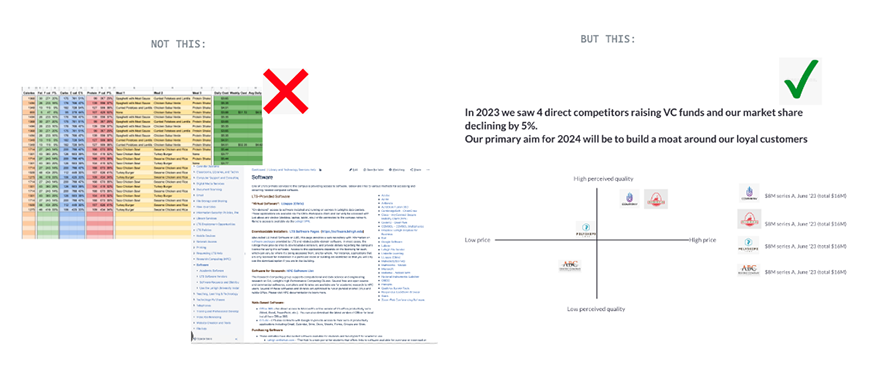
Remember, visual aids make it much easier to digest information quickly, and a nice narrative makes things resonate and stick (a big hurray for good storytellers!).
There are plenty of tools that can help make your work visible, e.g., ClickUp, Miro, and Notion. Most teams I encounter are using Slack (good for you, Slack), so you can even simply send a weekly update in a (dedicated) Slack channel:
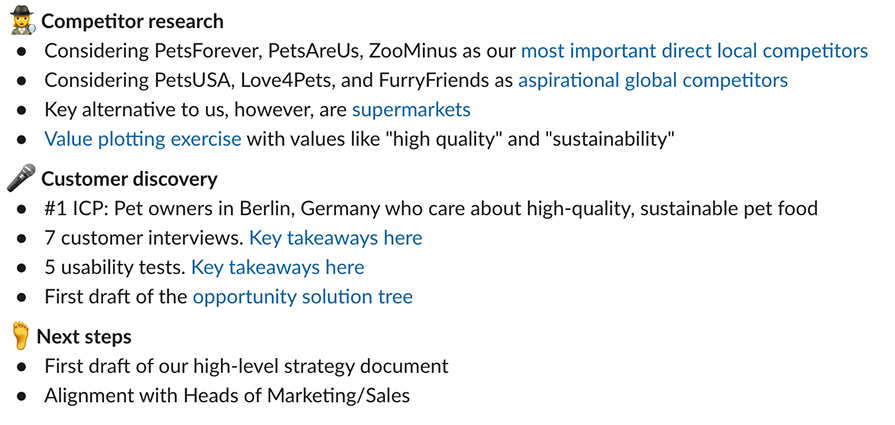
“It’s not me, it’s you.”
Let’s be honest, many of us have had this thought. But before you point the finger, check yourself critically. Are you truly giving others an honest chance to participate by doing all the things outlined above? Is there anything you could improve on?
If nothing comes to mind, is there anyone within your organization you can talk to who will honestly tell you what’s going wrong?
If you truly find yourself in a desperate situation, you might need to start looking for a better environment. In most cases though, there’s something you can do to improve.
In my experience, there are a few big mistakes I’ve seen with co-creation. Keep them in mind so you don’t fall into the same trap:
The bad news? Effective co-creation requires breaking down some tricky internal barriers, such as a lack of self-confidence or trust in your colleagues, or a misunderstanding of your role. The good news: it’s a muscle you can train.
With every project, ask yourself:
Happy co-creating!
Featured image source: IconScout

LogRocket identifies friction points in the user experience so you can make informed decisions about product and design changes that must happen to hit your goals.
With LogRocket, you can understand the scope of the issues affecting your product and prioritize the changes that need to be made. LogRocket simplifies workflows by allowing Engineering, Product, UX, and Design teams to work from the same data as you, eliminating any confusion about what needs to be done.
Get your teams on the same page — try LogRocket today.

A practical five minute revenue estimation method to help product managers compare ideas, drop low impact features, and prioritize smarter.

A practical guide for PMs who want to stop being bottlenecks, delegate smarter, and lead teams effectively with a clear ownership framework.

Stop letting unreliable data block features. Treat data as inventory to track quality, ownership, and ship with confidence.

Learn why slide decks slow teams down and explore better tools like whiteboards, PRDs, and prototypes to improve collaboration and alignment.